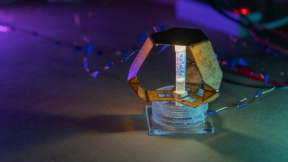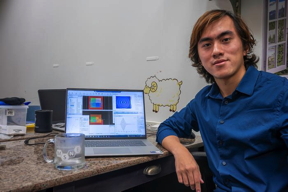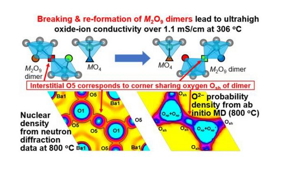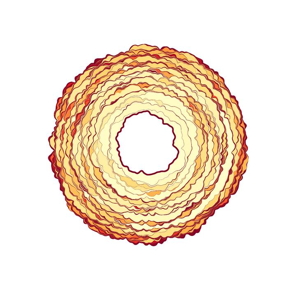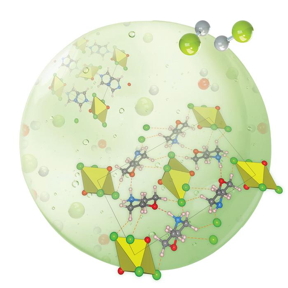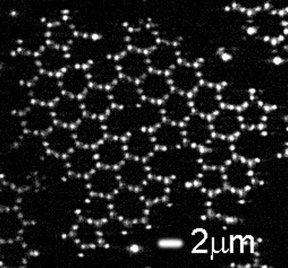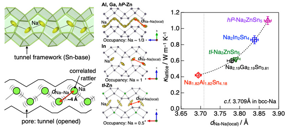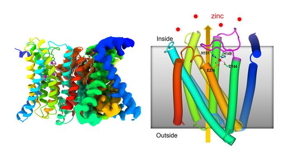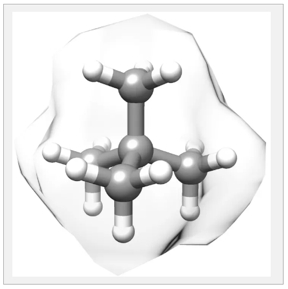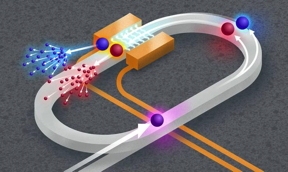Home > Press > TU Delft researchers discover new ultra strong material for microchip sensors: A material that doesn’t just rival the strength of diamonds and graphene, but boasts a yield strength 10 times greater than Kevlar, renowned for its use in bulletproof vests
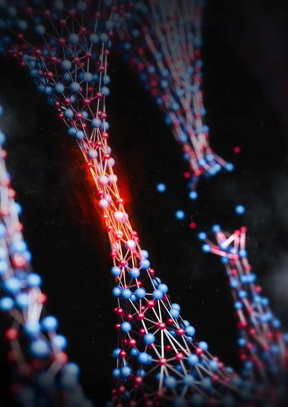 |
| Cover of Advanced Materials with an artist impression of amorphous silicon carbide nanostrings testing to it’s limit tensile strenght. CREDIT Science Brush |
Abstract:
Researchers at Delft University of Technology, led by assistant professor Richard Norte, have unveiled a remarkable new material with potential to impact the world of material science: amorphous silicon carbide (a-SiC). Beyond its exceptional strength, this material demonstrates mechanical properties crucial for vibration isolation on a microchip. Amorphous silicon carbide is therefore particularly suitable for making ultra-sensitive microchip sensors.
TU Delft researchers discover new ultra strong material for microchip sensors: A material that doesn’t just rival the strength of diamonds and graphene, but boasts a yield strength 10 times greater than Kevlar, renowned for its use in bulletproof vests
Delft, Netherlands | Posted on November 3rd, 2023
The range of potential applications is vast. From ultra-sensitive microchip sensors and advanced solar cells, to pioneering space exploration and DNA sequencing technologies. The advantages of this material’s strength combined with its scalability make it exceptionally promising.
Ten medium-sized cars
“To better understand the crucial characteristic of “amorphous”, think of most materials as being made up of atoms arranged in a regular pattern, like an intricately built Lego tower,” explains Norte. “These are termed as “crystalline” materials, like for example, a diamond. It has carbon atoms perfectly aligned, contributing to its famed hardness.” However, amorphous materials are akin to a randomly piled set of Legos, where atoms lack consistent arrangement. But contrary to expectations, this randomisation doesn’t result in fragility. In fact, amorphous silicon carbide is a testament to strength emerging from such randomness.
The tensile strength of this new material is 10 GigaPascal (GPa). “To grasp what this means, imagine trying to stretch a piece of duct tape until it breaks. Now if you’d want to simulate the tensile stress equivalent to 10 GPa, you’d need to hang about ten medium-sized cars end-to-end off that strip before it breaks,” says Norte.
Nanostrings
The researchers adopted an innovative method to test this material’s tensile strength. Instead of traditional methods that might introduce inaccuracies from the way the material is anchored, they turned to microchip technology. By growing the films of amorphous silicon carbide on a silicon substrate and suspending them, they leveraged the geometry of the nanostrings to induce high tensile forces. By fabricating many such structures with increasing tensile forces, they meticulously observed the point of breakage. This microchip-based approach not only ensures unprecedented precision but also paves the way for future material testing.
Why the focus on nanostrings? “Nanostrings are fundamental building blocks, the very foundation that can be used to construct more intricate suspended structures. Demonstrating high yield strength in a nanostring translates to showcasing strength in its most elemental form.”
From micro to macro
And what finally sets this material apart is its scalability. Graphene, a single layer of carbon atoms, is known for its impressive strength but is challenging to produce in large quantities. Diamonds, though immensely strong, are either rare in nature or costly to synthesize. Amorphous silicon carbide, on the other hand, can be produced at wafer scales, offering large sheets of this incredibly robust material.
“With amorphous silicon carbide’s emergence, we’re poised at the threshold of microchip research brimming with technological possibilities,” concludes Norte.
####
For more information, please click here
Contacts:
Media Contact
Marc Kool
Delft University of Technology
Expert Contact
Richard Norte
Delft University of Technology
Copyright © Delft University of Technology
If you have a comment, please Contact us.
Issuers of news releases, not 7th Wave, Inc. or Nanotechnology Now, are solely responsible for the accuracy of the content.
| Related Links |
| Related News Press |
Graphene/ Graphite
![]() Ferroelectrically modulate the Fermi level of graphene oxide to enhance SERS response November 3rd, 2023
Ferroelectrically modulate the Fermi level of graphene oxide to enhance SERS response November 3rd, 2023
News and information
![]() Nanoparticle quasicrystal constructed with DNA: The breakthrough opens the way for designing and building more complex structures November 3rd, 2023
Nanoparticle quasicrystal constructed with DNA: The breakthrough opens the way for designing and building more complex structures November 3rd, 2023
![]() What a “2D” quantum superfluid feels like to the touch November 3rd, 2023
What a “2D” quantum superfluid feels like to the touch November 3rd, 2023
2 Dimensional Materials
![]() Nanoparticle quasicrystal constructed with DNA: The breakthrough opens the way for designing and building more complex structures November 3rd, 2023
Nanoparticle quasicrystal constructed with DNA: The breakthrough opens the way for designing and building more complex structures November 3rd, 2023
![]() What a “2D” quantum superfluid feels like to the touch November 3rd, 2023
What a “2D” quantum superfluid feels like to the touch November 3rd, 2023
Possible Futures
![]() Light guide plate based on perovskite nanocomposites November 3rd, 2023
Light guide plate based on perovskite nanocomposites November 3rd, 2023
![]() Charged “molecular beasts” the basis for new compounds: Researchers at Leipzig University use “aggressive” fragments of molecular ions for chemical synthesis November 3rd, 2023
Charged “molecular beasts” the basis for new compounds: Researchers at Leipzig University use “aggressive” fragments of molecular ions for chemical synthesis November 3rd, 2023
![]() Study on Magnetic Force Microscopy wins 2023 Advances in Magnetism Award: Analysis of finite size effects reveals significant consequences for density measurements November 3rd, 2023
Study on Magnetic Force Microscopy wins 2023 Advances in Magnetism Award: Analysis of finite size effects reveals significant consequences for density measurements November 3rd, 2023
![]() Ferroelectrically modulate the Fermi level of graphene oxide to enhance SERS response November 3rd, 2023
Ferroelectrically modulate the Fermi level of graphene oxide to enhance SERS response November 3rd, 2023
Chip Technology
![]() Charged “molecular beasts” the basis for new compounds: Researchers at Leipzig University use “aggressive” fragments of molecular ions for chemical synthesis November 3rd, 2023
Charged “molecular beasts” the basis for new compounds: Researchers at Leipzig University use “aggressive” fragments of molecular ions for chemical synthesis November 3rd, 2023
![]() A new qubit platform is created atom by atom October 6th, 2023
A new qubit platform is created atom by atom October 6th, 2023
![]() Twisted science: NIST researchers find a new quantum ruler to explore exotic matter October 6th, 2023
Twisted science: NIST researchers find a new quantum ruler to explore exotic matter October 6th, 2023
![]() Successful morphing of inorganic perovskites without damaging their functional properties October 6th, 2023
Successful morphing of inorganic perovskites without damaging their functional properties October 6th, 2023
Nanotubes/Buckyballs/Fullerenes/Nanorods/Nanostrings
![]() Tests find no free-standing nanotubes released from tire tread wear September 8th, 2023
Tests find no free-standing nanotubes released from tire tread wear September 8th, 2023
![]() Detection of bacteria and viruses with fluorescent nanotubes July 21st, 2023
Detection of bacteria and viruses with fluorescent nanotubes July 21st, 2023
![]() Current and Future Developments in Nanomaterials and Carbon Nanotubes: Applications of Nanomaterials in Energy Storage and Electronics October 28th, 2022
Current and Future Developments in Nanomaterials and Carbon Nanotubes: Applications of Nanomaterials in Energy Storage and Electronics October 28th, 2022
Sensors
![]() Electron collider on a chip June 30th, 2023
Electron collider on a chip June 30th, 2023
![]() Researchers discover materials exhibiting huge magnetoresistance June 9th, 2023
Researchers discover materials exhibiting huge magnetoresistance June 9th, 2023
![]() Laser direct writing of Ga2O3/liquid metal-based flexible humidity sensors May 12th, 2023
Laser direct writing of Ga2O3/liquid metal-based flexible humidity sensors May 12th, 2023
![]() Diamond cut precision: University of Illinois to develop diamond sensors for neutron experiment and quantum information science April 14th, 2023
Diamond cut precision: University of Illinois to develop diamond sensors for neutron experiment and quantum information science April 14th, 2023
Discoveries
![]() Nanoparticle quasicrystal constructed with DNA: The breakthrough opens the way for designing and building more complex structures November 3rd, 2023
Nanoparticle quasicrystal constructed with DNA: The breakthrough opens the way for designing and building more complex structures November 3rd, 2023
![]() What a “2D” quantum superfluid feels like to the touch November 3rd, 2023
What a “2D” quantum superfluid feels like to the touch November 3rd, 2023
Announcements
![]() Light guide plate based on perovskite nanocomposites November 3rd, 2023
Light guide plate based on perovskite nanocomposites November 3rd, 2023
![]() Charged “molecular beasts” the basis for new compounds: Researchers at Leipzig University use “aggressive” fragments of molecular ions for chemical synthesis November 3rd, 2023
Charged “molecular beasts” the basis for new compounds: Researchers at Leipzig University use “aggressive” fragments of molecular ions for chemical synthesis November 3rd, 2023
![]() Study on Magnetic Force Microscopy wins 2023 Advances in Magnetism Award: Analysis of finite size effects reveals significant consequences for density measurements November 3rd, 2023
Study on Magnetic Force Microscopy wins 2023 Advances in Magnetism Award: Analysis of finite size effects reveals significant consequences for density measurements November 3rd, 2023
![]() Ferroelectrically modulate the Fermi level of graphene oxide to enhance SERS response November 3rd, 2023
Ferroelectrically modulate the Fermi level of graphene oxide to enhance SERS response November 3rd, 2023
Interviews/Book Reviews/Essays/Reports/Podcasts/Journals/White papers/Posters
![]() Nanoparticle quasicrystal constructed with DNA: The breakthrough opens the way for designing and building more complex structures November 3rd, 2023
Nanoparticle quasicrystal constructed with DNA: The breakthrough opens the way for designing and building more complex structures November 3rd, 2023
![]() What a “2D” quantum superfluid feels like to the touch November 3rd, 2023
What a “2D” quantum superfluid feels like to the touch November 3rd, 2023
- SEO Powered Content & PR Distribution. Get Amplified Today.
- PlatoData.Network Vertical Generative Ai. Empower Yourself. Access Here.
- PlatoAiStream. Web3 Intelligence. Knowledge Amplified. Access Here.
- PlatoESG. Carbon, CleanTech, Energy, Environment, Solar, Waste Management. Access Here.
- PlatoHealth. Biotech and Clinical Trials Intelligence. Access Here.
- Source: http://www.nanotech-now.com/news.cgi?story_id=57408
- :has
- :is
- :not
- :where
- $UP
- 10
- 12th
- 2023
- 21st
- 26
- 28th
- 30th
- 3rd
- 6th
- 7th
- 8th
- 9th
- a
- About
- accuracy
- Achieve
- adopted
- advanced
- Advanced materials
- advances
- advantages
- aligned
- also
- an
- analysis
- anchored
- and
- apart
- applications
- approach
- April
- ARE
- arranged
- arrangement
- artist
- AS
- Assistant
- At
- atom
- award
- Bacteria
- based
- basis
- battery
- BE
- before
- being
- Better
- Beyond
- Blocks
- boasts
- breaks
- breakthrough
- brimming
- Building
- built
- bulletproof
- but
- by
- CAN
- carbon
- carbon nanotubes
- cars
- Cells
- Center
- CGI
- challenging
- characteristic
- chemical
- click
- COM
- combined
- comment
- complex
- concludes
- Consequences
- consistent
- construct
- content
- contrary
- contributing
- Conversion
- cost-effective
- costly
- cover
- created
- credit
- crucial
- Cut
- damaging
- del
- demonstrates
- demonstrating
- density
- designing
- designs
- develop
- developing
- developments
- Devices
- Diamond
- direct
- discover
- dna
- doesn
- effects
- either
- electrolytes
- emergence
- emerging
- end
- end-to-end
- energy
- enhance
- ensures
- Equivalent
- Ether (ETH)
- example
- exceptional
- exceptionally
- Exhibiting
- Exotic
- expectations
- expected
- experiment
- Explains
- exploration
- explore
- fabricating
- fact
- famed
- fibers
- films
- Finally
- Find
- flexible
- Focus
- For
- Force
- Forces
- form
- Foundation
- fragility
- from
- functional
- fundamental
- future
- future developments
- geometry
- gif
- GPA
- Graphene
- grasp
- greater
- Growing
- guide
- hand
- Hang
- Have
- High
- High Yield
- However
- http
- HTTPS
- huge
- if
- illinois
- imagine
- immensely
- Impact
- impressive
- improvements
- in
- Inc.
- Including
- increasing
- incredibly
- industry
- inexpensive
- information
- innovative
- instead
- intricate
- introduce
- isolation
- IT
- ITS
- jpg
- July
- june
- just
- known
- Lack
- large
- layer
- Led
- Level
- leveraged
- light
- like
- LIMIT
- links
- made
- Magnetism
- make
- Making
- many
- March
- material
- materials
- May..
- means
- mechanical
- method
- methods
- meticulously
- micro
- Microscopy
- might
- molecular
- monumental
- more
- most
- Nanomaterials
- nanotechnology
- Nature
- Need
- net
- Netherlands
- New
- news
- next-generation
- nist
- no
- November
- now
- observed
- october
- of
- off
- offering
- on
- only
- opens
- optical
- or
- Other
- particularly
- Pattern
- pave
- paves
- perfectly
- PHP
- piece
- Pioneering
- plastic
- platform
- plato
- Plato Data Intelligence
- PlatoData
- please
- Point
- poised
- possibilities
- Post
- posted
- potential
- Precision
- press
- Press Release
- processing
- produce
- Produced
- produces
- Professor
- promising
- properties
- propose
- proposed
- Quantum
- quantum information
- Qubit
- randomness
- range
- RARE
- RE
- regular
- release
- released
- Releases
- remarkable
- Renowned
- research
- researchers
- responsible
- result
- return
- Reveals
- revolutionize
- Richard
- Rival
- robust
- Room
- s
- Save
- says
- Scalability
- scales
- Science
- scientists
- Search
- sensors
- September
- sequencing
- set
- Sets
- Share
- showcasing
- significant
- Silicon
- silicon carbide
- Simple
- simulate
- single
- Size
- solar
- Solar cells
- solely
- Soon
- Source
- Space
- space exploration
- start
- storage
- strength
- stress
- Strip
- strong
- structures
- submit
- such
- suitable
- suspended
- synthesize
- T
- tape
- technological
- Technologies
- Technology
- ten
- test
- testament
- Testing
- than
- that
- The
- the world
- their
- Them
- therefore
- they
- Think
- this
- though?
- threshold
- times
- tire
- to
- Tower
- traditional
- tread
- trying
- Turned
- Ultra
- understand
- university
- unprecedented
- until
- unveiled
- us
- use
- used
- Vast
- very
- viruses
- want
- Wave
- Way..
- we
- What
- Wins
- with
- without
- world
- writing
- Yahoo
- Yield
- you
- zephyrnet










